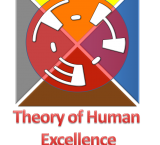of the human brain such as neuro-plasticity, mirror neurons, knowledge regarding dopamine reward circuits, how functional connection networks couple areas of the brain together to deliver the required cognition and then then reconfigure themselves. As a result of this research, new rational for behaviour has been revealed that is among the most significant intellectual developments for the human species in the last century.
The Theory of Excellence (THE) taxonomy of excellence has four tiers. The first tier is Natural Excellence which is based upon core Evolutionary theory including how animals compete or collaborate to survive; this is combined with elements of chaos theory, complex adaptive systems and the basics of life to deliver a complete set of principles that define the code of life at the highest level. This is the highest level that can be applied to all aspects of growth, change and development. It encompasses the principles and framework to develop a strategy to achieve a purpose and deliver the vision, understand the effort and reward balance together with the cycles involved with continuous improvement.
Human Excellence is the second tier that uses the Derived Value Cycle plus the Human Cognitive Framework to define the dynamics of human thought, plus all the parameters or influences that affect the brain’s performance such as nutrition, sleep, conflicting stimulus, energy reserves, stress, temporal demand, or general attitude towards the goal of the task. This facilitates skills such as accelerated learning and ensuring that the correct state of mind is used to deliver the required performance and achieve excellence. It ensures that the critical components are in place to deliver exceptional performance in any chosen role or pursuit. This framework is combined with the Human Decision Executive model that describes how the brain's central executive functions and processes the decision stack.
The next level is the Behaviour Map that categories types of cognitive thought and delivers a map for recognising the appropriate decision making process or behavioural traits including the rational for conflicting thoughts or behaviours both positive and negative. Incorporated within this tier is the Universal Profiling Model that is a versatile behaviour profiling system that can be applied to many areas including Integrated Cognition (also known as Integrative Thinking), personality profiling or to provide a complete model for defining, measuring and analysing innovation. Also, within this tier is the Nature of Teams framework. This promotes cooperation amongst humans and provides a framework containing the key principles, operational concepts and guidance for positive human interaction promoting strong collaboration and group excellence. The Behaviour Map is fundamental to defining the characteristics of learning, decisions, roles, interaction, collaboration, conflicts and categorising the types of behavioural processes humans portray.
The last tier within THE taxonomy is Process Optimisation that provides a set of attributes based upon the Dynamics of Excellence that can be used to describe and measure any process. This optimisation process can be used to define the ‘as is’ situation together with the desired ‘to be’ improvement. Actions can then be devised to steer the change process to deploy the improvements taking into consideration the effect on the employees involved, as a result of their behaviour map devised from the Universal Profile Model, and the Cognitive Load Template together with the feedback from the process.
The Theory of Excellence taxonomy ensures that all the necessary elements to achieve organisational, team, individual, or process excellence are identified, understood, deployed and monitored for sustainability. From the very top level of purpose down to the very detailed level of the attributes and characteristics of a particular task are incorporated providing a complete set of principles. Applying THE fundamentals within each tier ensures that the natural aspects and strengths of human cognition are capitalised upon so that improvement programs can be undertaken and excellence achieved.




You need to register in order to submit a comment.